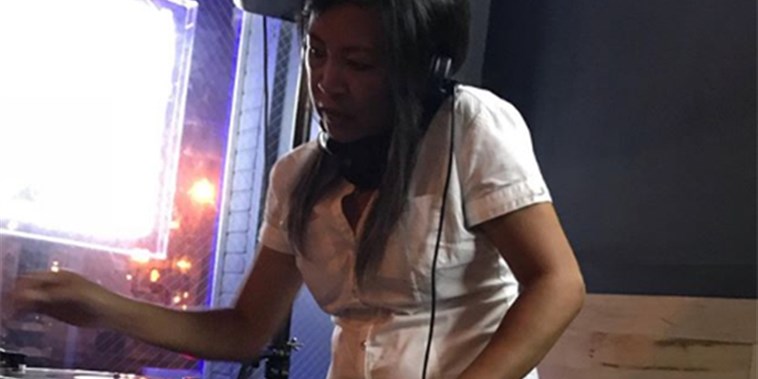Dylan Gramlich just wanted to show the world how cool his mom was: She had set up a pair of turntables and a mixer in their living room and would casually DJ. So on June 1, he recorded a video on his phone and posted it on Twitter.
The 15-second video shows Amy Gramlich casually, yet seamlessly, mixing two songs — Sage the Gemini’s “Gas Pedal” and City Girls’ “Act Up.” It’s received more than 1.6 million views. The Twitter response literally broke his phone, Dylan said, forcing him to buy a new one.
“She looked so happy doing it,” Dylan recalled. “And it made me happy.”
Dylan grew up knowing his mother used to be a DJ “back in the day” but never realized how much it mattered to her or her place in history.
“She always said she was part of a DJ crew with my ‘aunties’ but I never thought anything of it,” he said.
Amy Gramlich was a member of The GoGos, a mobile disc jockey group named after the famous all-female rock band, which the DJ group saw as their role models. Mobile DJ groups, which were prominent among Filipino Americans in the San Francisco Bay Area in the 1980s, played music at school dances, weddings and parties and were known for multigroup events.
The enthusiastic response to Dylan’s video showed that Amy hadn’t lost her touch. “Some comments were like, ‘I didn’t hear a mix?’ That’s how good I am if you didn’t hear the transition!” Amy laughed.
“I thought he was just playing around at first,” she added. “That’s why I danced to put a little something in it.”
Amy’s group started in 1980, when she was in the ninth grade, after she and her friends watched their boyfriends perform as mobile DJs.
“They taught us how to connect all the systems,” Amy said. “But we put the equipment together, carried our stuff into the venue, and did our mic checks.”
The GoGos are considered the first all-female crew in the mobile DJ scene. At the time, women were involved in almost everything but the turntables.
“They were mainly important as promoters and clients. You could argue, women also commanded a lot of power on the dance floor,” said Oliver Wang, a professor of sociology at California State University, Long Beach, who wrote “Legions of Boom: Filipino American DJ Crews in the San Francisco Bay Area.”
The GoGos consisted of seven girls: Amy was a mixer; along with her friend Liza; Daphne was the emcee and the rest were responsible for the staging and the lights.
They gained exposure by booking gigs. They earned credibility by participating in male-dominated battles, competitions where crews would put on the best show to win over a crowd. The GoGos often had a target on their backs.
“A lot of the crews were basically singling them out by challenging them to battle,” Wang said. “Many people also considered them to be some sort of gimmick.”
Battles were also an arena in which established crews took the stage, according to Wang’s book, so for a rising group like the GoGos — participating was outstanding.
“We came in third place,” Amy said about the GoGos’ first battle. “We didn’t expect to win but people began to take notice and were like, ‘Wow, they can really DJ.’ That’s how we started.”
My mom came from the Philippines when she was about 4 years old. She started djing at a very young age back when they only had vinyl. Her and my aunties were the first all female Filipino Dj group called the Gogos!
The group lasted four years, breaking up after high school to focus on college, careers and family but they never lost touch. Amy became a mother and began a 25-year career at Wells Fargo.
But the music never ceased to follow her. Amy credits her friend and fellow GoGo Daphne, who died recently of lung cancer, with encouraging her to get back in the game.
And a few years ago, another friend, who was hosting a 50th birthday celebration, surprised Amy by booking her for the party.
“I knew I was invited as a guest but she came up to me before and was like, ‘Hey, you’re DJing!’ I said, ‘I am?!’” Amy said.
That’s when she jumped into learning the new technology — and fell back in love with her long-held passion.
“Back in the day, we only had two turntables, a mixer, headphones, and ‘course vinyls,” Amy said. “The controllers they use nowadays, there’s more buttons you can work with, sound effects, and different ways to mix the songs.”

COMMENTS